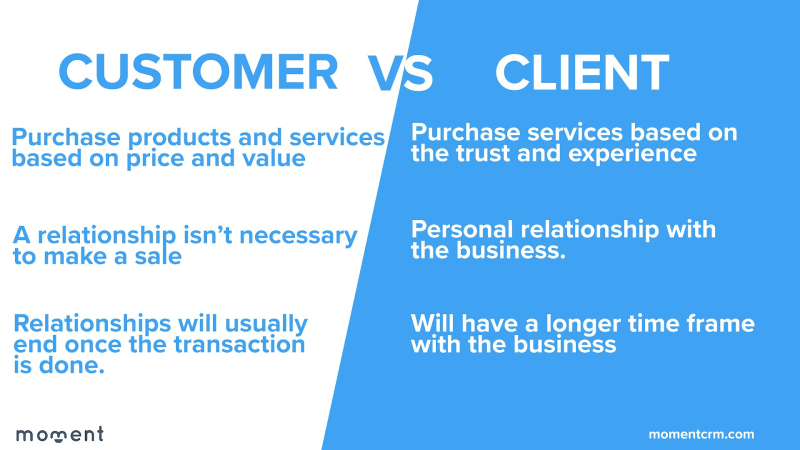The business environment in India is on a rapid upward trajectory for multiple reasons, including the growth of the country’s economy. In the evolving Indian businesses space, understanding the difference between a client and customer is pivotal for development. As a business owner in India, recognising the difference of client vs customer is crucial for building your brand image and creating long lasting relationships by tailoring your approach to meet their special requirements.

In this article, we will delve into the characteristics of clients vs customers, discuss the key differences between them, and explain why understanding this distinction is vital for Indian businesses!
Client vs customer: understanding clients
As we learn to differentiate between clients vs customers, let’s start with understanding the definitions. Who is a client, then?
A. Characteristics of clients
Clients are typically other businesses or professionals who engage with your services or products. In simple words, they are entities that receive services from a business in return for a payment. They form the foundation of business-to-business (B2B) relationships. Here are some defining characteristics of clients:
1. Long-Term Contracts: Most of the time, clients will enter into long-term commitments or partnerships with your business. They are basically long-term buddies of your business and steady sources of income. These contracts can span months, years, or even decades.
2. Customised Services: Clients more often than not require tailored solutions and personalised attention to meet their specific requirements. They require customised products or services that align with their business objectives.
3. Mutual Trust: Building trust is essential in client relationships, as they depend on your expertise and reliability. Trust is often developed over time and is the foundation of long-lasting B2B (business-to-business) partnerships.
B. Build your client relationship
For Indian businesses, nurturing client relationships involves several key strategies:
1. Effective Communication: Regularly updating clients on project progress, addressing their concerns promptly, and being responsive to their needs are pivotal for maintaining trust and satisfaction for both parties.
2. Customisation: Offering personalised solutions and adapting your products or services to meet their needs demonstrates your commitment and dedication to their success.
3. Going the Extra Mile: Putting in your best efforts at all times to exceed client expectations can help solidify long-term partnerships. To set your India businesses apart, delivering exceptional value and service is essential.
Client vs customer: understanding customers
Now, as we continue to explore clients vs customers, it’s time to understand who customers are:
A. Characteristics of customers
Customers are individuals that buy goods or services in exchange for money. They are typically part of the B2C (business-to-consumer) market. Here are some defining characteristics of customers:
1. Single Payment: Customers make one-time purchases or occasional transactions. They may buy your product or service only when they have a specific need, and generate revenue for your Indian businesses.
2. Varied Statistics: Customers have diverse backgrounds, preferences, and buying behaviours. They may belong to different age groups, income brackets, and geographic locations.
3. Price Conscious: Customers are often more price-conscious and may prioritise affordability as per their income. They are more likely to compare prices and seek discounts or deals.
B. Building customer relationships
To succeed, Indian businesses should focus on the following strategies:
Extraordinary services: Providing exceptional service during every interaction is crucial to leave a positive impression and encourage repeat buying. Great customer service can foster customer loyalty and brand image.
Customisation: Take customer feedback to understand the data to personalise recommendations and offers based on individual preferences and purchase history. This enhances the customer's connection with your brand. Personalisation can create a sense of belonging and loyalty.
Loyalty programs: Implementing loyalty programs to reward repeat customers or new customers and incentivize future purchases can increase customer retention and drive repeat business. Loyalty programs are particularly effective in the B2C sector.
Client vs customer: key differences
It’s time to discover the key differences between clients vs customers. Let’s take a quick look:
1. Longevity of relationship: Clients engage in long-term contracts with your business, while customers are typically one-time or occasional buyers. Clients often provide a stable source of revenue, while customers may result in more fluctuating income.
2. Priorities: Clients require personalised solutions tailored to their specific needs, while customers may prioritise convenience and affordability.
3. Trust and relationship factors: Building trust is crucial with clients who rely on your expertise and reliability. In contrast, customers may focus more on product quality, value, and customer service.
To summarise, here are the primary differences of clients vs customers:

Why knowing the difference of client vs customer matters for Indian businesses
Due to the broad and often changing market conditions, Indian firms must understand the difference between clients vs customers. Here's why it matters:
1. Tailored marketing: Recognising your audience allows you to tailor your marketing efforts more effectively. B2B marketing should focus on demonstrating expertise and a result-driven approach. In B2C, customers emphasise convenience and affordability. Understanding your target audience helps allocate resources wisely.
2. Revenue stability: Clients often provide a stable source of revenue, reducing the impact of market fluctuations. Building strong client relationships can ensure consistent income for your business, even during economic uncertainties.
3. Market expansion: Expanding your client base and customer segments can open up new opportunities for growth and success in the Indian market. Understanding the diverse needs and preferences of clients vs customers can help you expand your market reach.
Client vs customer: tailoring the approach for Indian businesses
In the last leg of this blog, we outline some strategies for your business to build the best possible connections with your client vs customer:
A. B2B strategies for clients
Here is how you can provide the best service to your clients:
1. Industry knowledge: Deep grasp of the client's industry is required to show that you are confident in your abilities to handle their particular needs.
2. Relationship building: Invest in building long-term relationships through regular communication and exceeding expectations. A strong client relationship often goes beyond just business; it's built on trust and mutual respect.
3. Customised solutions: Offer tailored solutions and be adaptable to changes in the client's requirements. Flexibility and the ability to pivot as their needs evolve are key to maintaining client satisfaction.
B. B2C Strategies for Customers
Now, here are some ways to ensure customer satisfaction:
1. Customer service: Provide exceptional customer service. Respond promptly to inquiries, resolve issues efficiently, go the extra mile to find solutions. Having a secure payment gateway and creating positive experiences are crucial to building customer loyalty.
2. Feedback: Encourage customer feedback and actively seek input to improve your products or services. Use feedback as a tool for refinement and enhancement.
3. Personalisation: Leverage data (i.e. feedback and other customer insights) to personalise recommendations and offers. Make your customers feel valued, show that you understand their preferences and needs.
Navigate Indian business space smoothly
In the evolving and competitive Indian business segment, understanding the difference between client vs customer is a strategic imperative. Tailoring your approach to meet the distinct needs and expectations of these two groups can lead to lasting relationships, revenue stability, and sustainable growth.
Looking for a banking partner to help your business expand globally? SALT Fintech can be the right partner for you! With us, you can receive international payments in local accounts in a compliant and hassle-free manner, that too at the lowest fees and zero additional charges! Give our website a visit today to find out more, and join the SALT community today!
FAQs
How crucial is trust in dealings with clients?
Trust is of paramount importance in client relationships. Building trust fosters a strong client base, which is the foundation of B2B success. Trust can be built through consistent delivery of value, transparent communication, and fulfilling commitments.How can you broaden your clientele and target new customer groups in the Indian market?
Start by comprehending the industry trends to spot new prospects. Recognise the wants and preferences of your Indian market. Create focused marketing efforts that are specific to each market niche and adjust your offerings accordingly.


